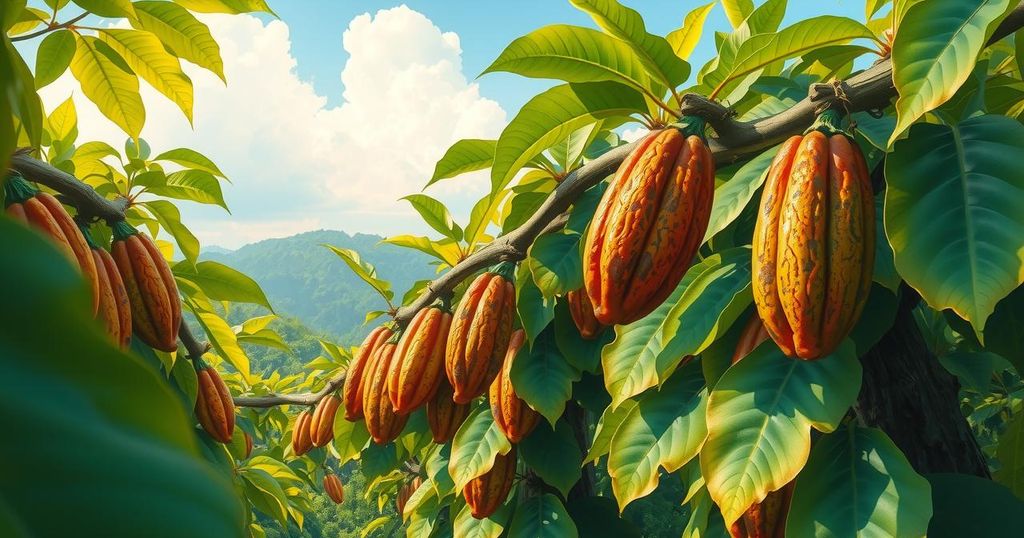Nigeria is seeking to bolster its cocoa production in response to soaring global prices, aiming for significant growth as it grapples with challenges posed by smallholder farming and environmental practices. The government aspires to elevate Nigeria’s position in global production while addressing issues such as the reliance on monocrop farming and the need for investment in sustainable practices.
Nigeria is exploring opportunities to become a more significant player in the cocoa industry, especially as global cocoa prices reached a record high of $12,000 per tonne in December. With the challenges faced by leading producers Ivory Coast and Ghana due to climate change and disease, Nigeria’s cocoa sector has garnered increased interest from investors who seek to diversify from the oil-dependent economy.
According to Patrick Adebola, executive director at the Cocoa Research Institute of Nigeria, “The farmers have never had it so good.” In light of this surge in prices, over a dozen local companies have shown interest in expanding their production capabilities. Additionally, a notable investment of $40.5 million was made by the British government’s development finance arm into Nigerian agribusiness company Johnvents.
Nigeria is currently the seventh-largest cocoa producer worldwide, generating over 280,000 tonnes in 2023, with a government target set for 500,000 tonnes in the 2024-2025 season. Achieving this target would elevate Nigeria to the fourth position in global cocoa production, trailing Ivory Coast, Ghana, and Indonesia. While Adebola expresses skepticism about meeting this target immediately, he sees potential growth as interest in revitalizing old plantations increases.
The cocoa market dynamics differ significantly for Nigerian farmers compared to their counterparts in Ivory Coast and Ghana, particularly because prices are predetermined in the latter two nations. Although cocoa futures contracts in New York have decreased from their peak, they remain high at above $8,000 per tonne, following a period where prices fluctuated between $2,000 and $3,000.
As noted by Adeola Adegoke, president of the Cocoa Farmers Association of Nigeria, “Individuals are going into cocoa production at every level… to make sure they also enjoy the current price.” Despite being the world’s top producer, Ivory Coast’s harvests suffered recently, exacerbating the supply shortage and contributing to high global prices. Nigeria’s cocoa crops have thankfully, thus far, been less affected by climate change, though efforts to expand production may introduce environmental risks.
The Nigerian government aims to regulate and modernize the cocoa sector through the National Cocoa Management Committee, established in 2022. Nonetheless, modernization efforts have raised concerns regarding the reliance on “full-sun” monocrop farming, which prioritizes cocoa bean cultivation at the expense of biodiversity and environmental health, as suggested in a recent study published in Agroforestry Systems.
Challenges also arise from the fact that much of Nigeria’s cocoa cultivation is undertaken by small-scale farmers. Peter Okunde, a cocoa farmer from Ogun State, mentioned his lack of capital and land to expand his operations, emphasizing that land is essential for growth. Contrarily, John Alamu, managing director of Johnvents, pointed out that Nigeria possesses 1.4 million hectares devoted to cocoa farming, exceeding Ghana’s area yet indicating the need for a more comprehensive approach. Government-supported initiatives such as providing seedlings and training on agronomic practices are essential to revitalizing Nigeria’s cocoa sector and restoring its competitive standing.
In summary, Nigeria is positioning itself to enhance its role in the global cocoa market as soaring prices attract renewed investor interest. Despite ambitious production targets, the country faces challenges, including reliance on small-scale farmers and concerns over sustainable practices. With targeted government support and modernization strategies, Nigeria may overcome these obstacles and emerge as a leading cocoa producer in the coming years.
Original Source: business.inquirer.net




